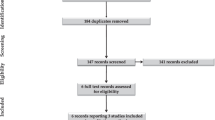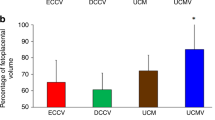Abstract
Objective:
To compare the effect of combined delayed cord clamping and umbilical cord milking to either of them had done alone, on hematological parameters at 6 weeks of age in term neonates.
Study design:
It was a randomized controlled trial, conducted during January to December 2014. Three hundred eligible neonates were randomly allocated to three parallel groups. Primary outcome was hemoglobin and serum ferritin at 6 weeks of age. Data were analyzed using analysis of variance and Kruskal–Wallis test.
Results:
Baseline characteristics and hemodynamic parameters were comparable in all the three groups. The median serum ferritin level at 6 weeks was significantly higher in the group receiving both delayed cord clamping and milking the cut cord group (295.49 (233.5 to 346.54) ng ml−1) as compared with the group that received only milking of the cut cord (184.55 (131.22 to 256.5) ng ml−1) or only delayed cord clamping (268.8 (189.4 to 315.44) ng ml−1).
Conclusion:
Delayed cord clamping with milking the cut cord improved iron stores at 6 weeks of age in term infants, then either of the two interventions alone.
This is a preview of subscription content, access via your institution
Access options
Subscribe to this journal
Receive 12 print issues and online access
$259.00 per year
only $21.58 per issue
Buy this article
- Purchase on Springer Link
- Instant access to full article PDF
Prices may be subject to local taxes which are calculated during checkout


Similar content being viewed by others
References
Kalaivani K . Prevalence & consequences of anaemia in pregnancy. Indian J Med Res 2009; 130 (5): 627–633.
McLean E, Cogswell M, Egli I, Wojdyla D, de Benoist B . Worldwide prevalence of anaemia, WHO Vitamin and Mineral Nutrition Information System, 1993-2005. Public Health Nutr 2009; 12 (4): 444–454.
Ministry of Health and Welfare. National Family Health Survey III (2005-2006): Nutrition in India. in: Government of India, 2009; 3–17.
World Health Organization Iron Deficiency Anaemia: Assessment, Prevention and Control-a Guide for Programme Managers. WHO: : Geneva, Switzerland, 2001.
Lozoff B, Clark KM, Jing Y, Armony-Sivan R, Angelilli ML, Jacobson SW . Dose-response relationships between iron deficiency with or without anemia and infant social-emotional behavior. J Pediatr 2008; 152 (5): 696–702, 702.31–3.
Roncagliolo M, Garrido M, Walter T, Peirano P, Lozoff B . Evidence of altered central nervous system development in infants with iron deficiency anemia at 6 mo: delayed maturation of auditory brainstem responses. Am J Clin Nutr 1998; 68 (3): 683–690.
Carter RC, Jacobson JL, Burden MJ, Armony-Sivan R, Dodge NC, Angelilli ML et al. Iron deficiency anemia and cognitive function in infancy. Pediatrics 2010; 126 (2): e427–e434.
Drago SR, Valencia ME . Influence of components of infant formulas on in vitro iron, zinc, and calcium availability. J Agric Food Chem 2004; 52 (10): 3202–3207.
Hendricks GM, Guo MR, Kindstedt PS . Solubility and relative absorption of copper, iron, and zinc in two milk-based liquid infant formulae. Int J Food Sci Nutr 2001; 52 (5): 419–428.
Davidsson L, Galan P, Kastenmayer P, Cherouvrier F, Juillerat MA, Hercberg S et al. Iron bioavailability studied in infants: the influence of phytic acid and ascorbic acid in infant formulas based on soy isolate. Pediatr Res 1994; 36 (6): 816–822.
Lund EK, Wharf SG, Fairweather-Tait SJ, Johnson IT . Oral ferrous sulfate supplements increase the free radical-generating capacity of feces from healthy volunteers. Am J Clin Nutr 1999; 69 (2): 250–255.
Barry DM, Reeve AW . Increased incidence of gram-negative neonatal sepsis with intramuscula iron administration. Pediatrics 1977; 60 (6): 908–912.
Ben Hariz M, Goulet O, De Potter S, Girot R, Rambaud C, Colomb V et al. Iron overload in children receiving prolonged parenteral nutrition. J Pediatr 1993; 123 (2): 238–241.
Hamstra RD, Block MH, Schocket AL . Intravenous iron dextran in clinical medicine. JAMA 1980; 243 (17): 1726–1731.
Ultee CA, van der Deure J, Swart J, Lasham C, van Baar AL . Delayed cord clamping in preterm infants delivered at 34 36 weeks’ gestation: a randomised controlled trial. Arch Dis Child Fetal Neonatal Ed 2008; 93 (1): F20–F23.
Ibrahim HM, Krouskop RW, Lewis DF, Dhanireddy R . Placental transfusion: umbilical cord clamping and preterm infants. J Perinatol Off J Calif Perinat Assoc 2000; 20 (6): 351–354.
Rabe H, Reynolds G, Diaz-Rossello J . Early versus delayed umbilical cord clamping in preterm infants. Cochrane Database Syst Rev 2004; (4): CD003248.
Hutton EK, Hassan ES . Late vs early clamping of the umbilical cord in full-term neonates: systematic review and meta-analysis of controlled trials. JAMA 2007; 297 (11): 1241–1252.
Van Rheenen P, de Moor L, Eschbach S, de Grooth H, Brabin B . Delayed cord clamping and haemoglobin levels in infancy: a randomised controlled trial in term babies. Trop Med Int Health 2007; 12 (5): 603–616.
McDonald SJ, Middleton P, Dowswell T, Morris PS . Effect of timing of umbilical cord clamping of term infants on maternal and neonatal outcomes. Evid Based Child Health 2014; 9 (2): 303–397.
Hosono S, Mugishima H, Fujita H, Hosono A, Minato M, Okada T et al. Umbilical cord milking reduces the need for red cell transfusions and improves neonatal adaptation in infants born at less than 29 weeks’ gestation: a randomised controlled trial. Arch Dis Child Fetal Neonatal Ed 2008; 93 (1): F14–F19.
March MI, Hacker MR, Parson AW, Modest AM, de Veciana M . The effects of umbilical cord milking in extremely preterm infants: a randomized controlled trial. J Perinatol 2013; 33 (10): 763–767.
Upadhyay A, Gothwal S, Parihar R, Garg A, Gupta A, Chawla D et al. Effect of umbilical cord milking in term and near term infants: randomized control trial. Am J Obstet Gynecol 2013; 208 (2): 120.e1–6.
Rabe H, Jewison A, Alvarez RF, Crook D, Stilton D, Bradley R et al. Milking compared with delayed cord clamping to increase placental transfusion in preterm neonates: a randomized controlled trial. Obstet Gynecol 2011; 117 (2 Pt 1): 205–211.
Video Presentation: Vicki Taylor (for Professor William Tarnow-Mordi) on Correct umbilical cord ‘milking’ technique. Australian Placental Transfusion Study, West Mead Hospital. Sydney, Australia. (cited on 2 February 2015). Available at http://www.videos.med.usyd.edu.au/unitube/videos/file19/.
Jaiswal P, Upadhyay A, Gothwal S, Garg A, Upadhyay A . To Compare the Effect of Umbilical Cord Milking and Delayed Cord Clamping on Haematological Parameters in Term Neonates. Pediatric Academic Societies and Asian Society for Pediatric Research: : Vancouver, Canada, 2014.
Blouin B, Penny ME, Maheu-Giroux M, Casapía M, Aguilar E, Silva H et al. Timing of umbilical cord-clamping and infant anaemia: the role of maternal anaemia. Paediatr Int Child Health 2013; 33 (2): 79–85.
Wallgren G, Karlberg P, Lind J . Studies of the circulatory adaptation immediately after birth. Acta Paediatr 1960; 49: 843–849.
McCAUSLAND AM, Holmes F, Schumann WR . Management of cord and placental blood and its effect upon the newborn. Calif Med 1949; 71 (3): 190–196.
Patel S, Clark EAS, Rodriguez CE, Metz TD, Abbaszadeh M, Yoder BA . Effect of umbilical cord milking on morbidity and survival in extremely low gestational age neonates. Am J Obstet Gynecol 2014; 211 (5): 519.e1–7.
Ceriani Cernadas JM, Carroli G, Pellegrini L, Ferreira M, Ricci C, Casas O et al. [The effect of early and delayed umbilical cord clamping on ferritin levels in term infants at six months of life: a randomized, controlled trial]. Arch Argent Pediatr 2010; 108 (3): 201–208.
Andersson O, Domellöf M, Andersson D, Hellström-Westas L . Effect of delayed vs early umbilical cord clamping on iron status and neurodevelopment at age 12 months: a randomized clinical trial. JAMA Pediatr 2014; 168 (6): 547–554.
Mercer JS, Vohr BR, Erickson-Owens DA, Padbury JF, Oh W . Seven-month developmental outcomes of very low birth weight infants enrolled in a randomized controlled trial of delayed versus immediate cord clamping. J Perinatol 2010; 30 (1): 11–16.
Vain NE, Satragno DS, Gorenstein AN, Gordillo JE, Berazategui JP, Alda MG et al. Effect of gravity on volume of placental transfusion: a multicentre, randomised, non-inferiority trial. Lancet 2014; 384 (9939): 235–240.
Jain R, Jain A, Devgan V . Effect of Alternative Positions of Newborn (Relative to Placenta), Prior to Recommended Delayed Cord Clamping on Placental Transfusion – a Randomized Control Trial. Pediatric Academic Societies and Asian Society for pediatric Research: : Vancouver, Canada, 2014.
Acknowledgements
We thank the parents and resident doctors of Department of Pediatrics and Obstetrics for their valuable support. This study was also registered in Clinical Trial Registry of India (CTRI). CTRI/2014/10/005116.
Author information
Authors and Affiliations
Corresponding author
Ethics declarations
Competing interests
The authors declare no conflict of interest.
Rights and permissions
About this article
Cite this article
Yadav, A., Upadhyay, A., Gothwal, S. et al. Comparison of three types of intervention to enhance placental redistribution in term newborns: randomized control trial. J Perinatol 35, 720–724 (2015). https://doi.org/10.1038/jp.2015.65
Received:
Revised:
Accepted:
Published:
Issue Date:
DOI: https://doi.org/10.1038/jp.2015.65
This article is cited by
-
Effect of Umbilical Cord Milking on Maternal and Neonatal Outcomes in a Tertiary Care Hospital in South India: A Randomized Control Trial
The Journal of Obstetrics and Gynecology of India (2022)
-
Umbilical cord milking versus delayed cord clamping in term infants: a systematic review and meta-analysis
Journal of Perinatology (2021)
-
Effect of Umbilical Cord Milking vs Delayed Cord Clamping on Venous Hematocrit at 48 Hours in Late Preterm and Term Neonates: A Randomized Controlled Trial
Indian Pediatrics (2020)
-
Optimal Timing and Methodology of Umbilical Cord Clamping in Preterm Infants: a Review
Current Pediatrics Reports (2019)
-
Whole blood volumes associated with milking intact and cut umbilical cords in term newborns
Journal of Perinatology (2018)



